Some years ago a painting came to mind that I had last seen in my teens and had since disappeared under a dusty pile of memories. I remembered the curious element of some colourful birds placed in a prominent position and warm light emanating from the centre of an architectural setting, in which a solitary studious man is seated. It was an image of equilibrium: human endeavour balanced against the power of nature. Although I didn’t know the name of the artist nor a title or a date, the idea of this picture and the need to see it became an obsession.
One day, skimming through a magazine I stumbled across a reproduction and instantly recognised it as a popular renaissance subject; St. Jerome in his Study, by Antonello da Messina. I re-encountered the work, in an exhibition in Rome. An example of early Italian oil painting, executed on a wooden panel it measures a mere 45,7 x 36,2 cm; a small aperture onto an entire universe.
We see, a scholar, at work in his study (a wooden box-like construction walled with bookshelves and just large enough to house a desk and a chair.) This in turn is situated within a grand, stone built, ecclesiastic building dominated by Romanesque windows and Gothic arches. The scene is framed by a window casement. We stand outside and are offered a voyeuristic view into Jerome’s world. A man with a worldly face is engrossed in a book and apparently unaware of our presence. The lion he tamed roams the shadows. A peacock and another exotic bird have come to rest very close to us on the window ledge. A grey cat sits at his feet. We are able to see through windows on the far side of the building beyond this silent contemplative moment into the skies, a town and the landscape beyond.
It is an illustration of isolated concentration, but also acute awareness of the greater world. An image of the state of mind required for all creative endeavour.
Aaaaahh the Orient, the Levant, the cradle of civilization. Africa and Europe are both near and far.
Veils.
A hubble bubble at every street café. Never offer your left hand or else there's trouble. Some members of the opposite sex won't even shake hands at all. If it can’t be avoided they have to wash afterwards.
Further on we find belly dancing, heavy make up, naked flesh. Men are real men round here, proud and hot tempered. They kiss and caress each other in public. Hidden desires sometimes surface.
At home, the family, relations, friends. In the street Almighty God, five times a day, Allahu Akbar. Next comes his Royal Highness the King. His image is pasted on every wall lest we forget who is looking after us. Around the corner big trouble . . . better not mention it, the blind spot.
A region populated by Arabs, Muslims, Jews, Christians, Druses, Alawites, Maronites, Palestinians, Armenians and Kurds, to name but a few ethnic and religious groups. It is difficult for us to know where to begin when we start to try and understand the Middle East (a frustratingly general denomination for a region of such outstanding diversity.) Do we have a responsibility where all our crusaders, colonisers, protectors and diplomats made a mess, or should we finally leave distant neighbours and relatives to their own devices? It seems comfortable to settle down and lap up Arab hospitality, but once we do so we are entering a dialogue the terms, conditions and vocabulary of which we seem ill equipped to understand or reciprocate.
During the cold war, 20 years ago, we used to mean something else when we spoke of east and west, nowadays we are referring to Orient and Occident. A big difference but nevertheless both relationships are dominated by fear and suspicion. I'm ashamed to say we know much less about them than they know about us.
Mention "the Arabs" at home and many, from taxi driver to politician may offer a tirade painting pictures of brutal males grinding their oppressed wives' and daughters' noses into the dust, frenzied Islamist fundamentalists preaching to crazed mobs, suicide bombers, hijackers and hostage takers.
How are we perceived by the taxi driver in Amman? Greedy selfish exploiters of a cheap labour force, impotent, wife swappers, adulterers and neglectful parents, purveyors of a chauvinistic, single minded, self-centred insensitive worldview. The schoolyard bully who isn't brave enough to act without his big friend behind him. "Hitler good, America no good!" Oh dear!
When we travel east the colourful guidebooks ply us with camel rides and a smoke in front of a tent with a Bedouin Sikh. The spice and colour of the bazaar. The splendour of past civilizations. The mystery behind the veil. The Bible Lands. Lawrence of Arabia. A bit of sunshine and some Dead Sea salts.
. . . And what do our Arab brothers and sisters expect to find when they come and visit us? The superlative shopping experience? New clothes? Electronic goods? The sight of a fat cow on a lush green meadow surrounded by neatly clipped hedges? The joke posed by people obediently standing at a red light in front of an empty street in the middle of the night! Some Culture perhaps? A night at the Opera? Sex on the beach? "Oh no, I'm sorry, I forgot you don't drink alcohol do you? Would you like a sausage?"
We weren't meeting as diplomats and we didn't have a political agenda. We had a job on hand, we had to find a way of getting below the surface of prejudice and clichés and we didn't have much time. We just dived head first into intercultural relations, opened our eyes and then tried to find ways of staying afloat.
To enter a foreign environment is always a good means of obtaining a more objective view of your own culture. Travel, especially in solitude, can become a journey of revelations. None of the prophets entered the wilderness on a whim.
Together we entered the desert, a gabbling air-conditioned busload of 50. Far from the wind turbines and lush green meadows of home, we crossed shimmering sands singing, dancing and clapping to stare in awe at golden citadels and vast temples in the setting sun. When you came to us we showed you our history. You showed us your sparkling new cities but we wanted to see your slums. You were offended. We tried to explain.
Finally, in a state of exhaustion something happened, for a brief moment some of us manage to exit the constraints of our upbringing and see through your eyes. Exchange?
Alongside the cultural programme, we continuously worked, doing our job. No problems here, we know our stuff, or do we? We once thought we did.
(An abridged version of a text originally published in “Orientation” documenting two years of German Arab exchange, Academy of Visual Arts, Leipzig 2007)
When I was 20 I had spent two years at art school studying painting. It was an environment I had gone into because it seemed the logical thing to do but suddenly I felt lost. The thread I had been trying to follow was gone. I decided to learn a craft and became a printer.
It was through my work as a printer that I entered the world, a moderately grown up person and through this work that I slowly re-entered art. Most of my artistic production whether in painting, printmaking, drawing or as books is informed by graphic principles.
In several European languages „printmaking“ translates as „Grafik.“ I like this because coming from „graphite,“ an elemental drawing tool; it not only describes reproduceable images but the first tentative steps in the search for a new form. Within graphics we have, one the one hand, something primary, spontaneous, private and on the other we are dealing with a highly public, technological translation of visual information through abstract processes. The moment an artist creates a reproduceable work, then he or she is tapping into a popular idiom. Graphics are rooted in vernacular culture. They are less at home in the Temple, the museum and the palace than they are in the private space or on the street.
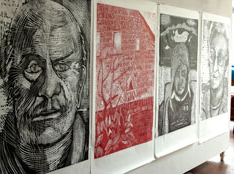
Images from an ongoing series of large format wood- and linocut prints begun in 2013. The portraits and scenes are set against a backdrop of stories of cultural displacement past and present, at home and abroad.
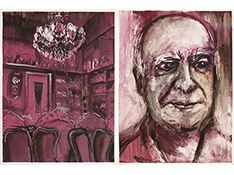
presents a picture of a cross section Damascene society at the beginning of the Syrian revolution. The project consists of 100 studies on paper and was hosted by the British Council Damascus shortly before it's closure in late 2011.
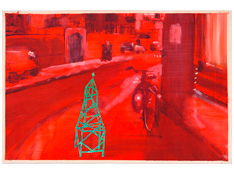
A series of 23 works
on paper made during a one month residency in Damascus, Autumn 2010.
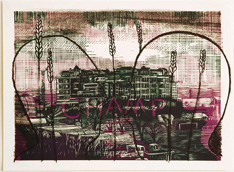
A series of 6 prints made using a combination of woodcut and lithographic techniques in Spring 2010 at Atelier à Fleur de Pierre in Paris. Produced in an edition of 20.
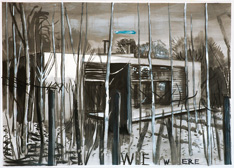
6 drawings from an island in the Baltic sea. March 2010.

From an ongoing series of 12 prints. All impressions were taken from one wood block as it was gradually transformed. 2004-2006
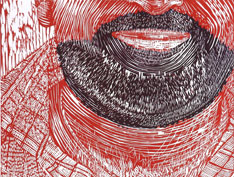
Works made in response to travels in the Middle East region 2007 – 2009. From a series of 10 images.
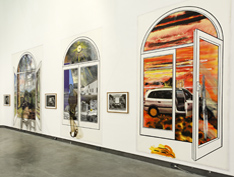
Three large format paintings inspired by the idea of St. Gerome.
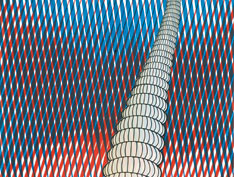
A series of 7 graphic images made in response to curator Frank Wagenbach’s exhibition Title: Der Wal oder Artisten in der Zirkuskuppel (The Whale or Trapeze Artists in the Circus Dome). Leipzig 2007.
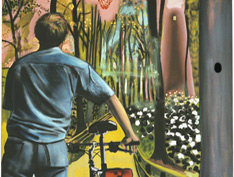
The most popular fairy tales are today firmly associated with a particular iconography located somewhere between Disney and 19 C medieval fantasies. The works gathered here were made in an attempt to assimilate and retell this tale.
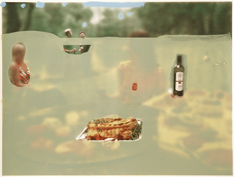
A summer picnic scene.
A series of 4 images, 2005.
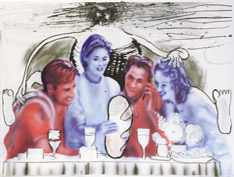
Images from a series of drawings made in 2004 whilst thinking about Philip Larkin.
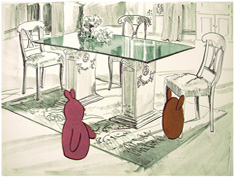
Examples of litho-graphs from 1997 – 2004
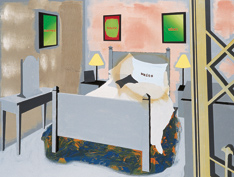
Wanderings through a bold and freshly united land 1998-99.